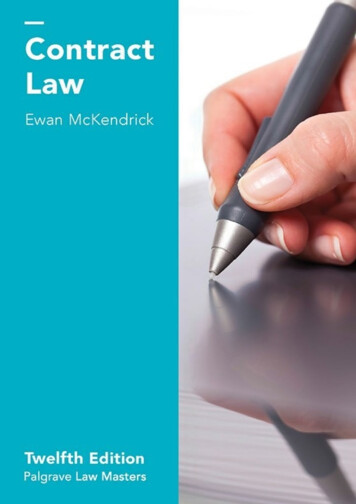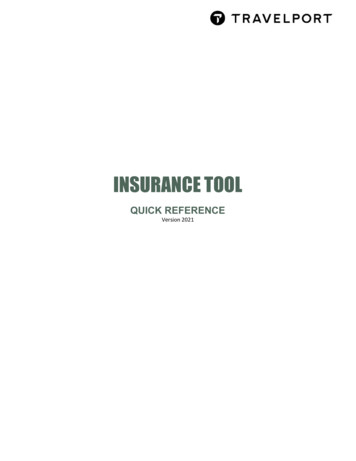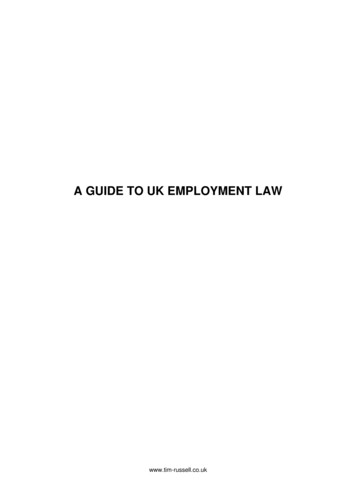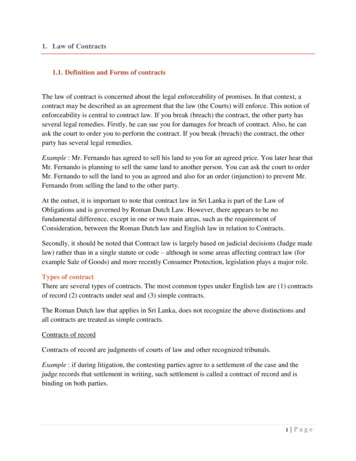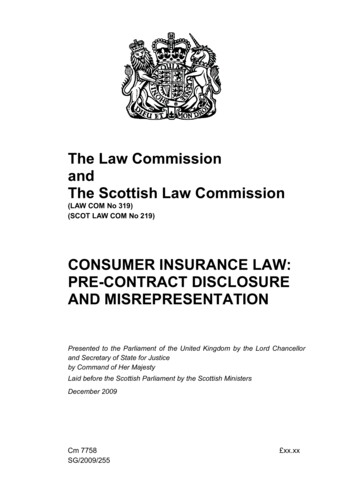
Transcription
The Law CommissionandThe Scottish Law Commission(LAW COM No 319)(SCOT LAW COM No 219)CONSUMER INSURANCE LAW:PRE-CONTRACT DISCLOSUREAND MISREPRESENTATIONPresented to the Parliament of the United Kingdom by the Lord Chancellorand Secretary of State for Justiceby Command of Her MajestyLaid before the Scottish Parliament by the Scottish MinistersDecember 2009Cm 7758SG/2009/255 xx.xx
ii
The Law Commission and the Scottish Law Commission were set up by the LawCommissions Act 1965 for the purpose of promoting the reform of the law.The Law Commissioners are:The Right Honourable Lord Justice Munby, ChairmanProfessor Elizabeth CookeMr David HertzellProfessor Jeremy HorderThe Chief Executive of the Law Commission is Mr Mark Ormerod CB.The Law Commission is located at Steel House, 11 Tothill Street, London SW1H 9LJ.The Scottish Law Commissioners are:The Honourable Lord Drummond Young, ChairmanLaura J Dunlop QCProfessor George L GrettonPatrick Layden QC, TDProfessor Hector L MacQueenThe Chief Executive of the Scottish Law Commission is Mr Malcolm McMillan.The Scottish Law Commission is located at 140 Causewayside, Edinburgh, EH9 1PR.The terms of this report were agreed on 16 November 2009.The text of this report is available on the Internet at:http://www.lawcom.gov.uk/insurance contract.htmhttp://www.scotlawcom.gov.ukiii
THE LAW COMMISSIONTHE SCOTTISH LAW COMMISSIONCONSUMER INSURANCE LAW: PRE-CONTRACTDISCLOSURE AND MISREPRESENTATIONCONTENTSParagraphPageviiLIST OF ABBREVIATIONS USED IN THIS REPORTPART 1: INTRODUCTION1Previous reportsA history of this projectA short, targeted BillGiving a statutory basis to ombudsman guidanceDifficulties with critical illness insuranceHard law or soft law?The structure of this report1.51.91.201.231.261.361.41PART 2: THE CURRENT POSITION: LAYERS OF LAW, RULES ANDGUIDANCEMarine Insurance Act 1906Alternatives to lawStatements of PracticeFinancial Services Authority rulesFinancial Ombudsman ServiceThe ABI Code of T 3: THE CASE FOR A NEW CONSUMER STATUTEThe FOS cannot protect all consumersThe rules are confusingThe effect on vulnerable groupsInappropriate rolesEuropean 73.532527313437
Paragraph38PART 4: THE RECOMMENDED SCHEME IN OUTLINEThe scope of the draft BillAbolishing the consumer’s duty to volunteer informationThe duty to take reasonable care not to misrepresentThe three-part classification“Basis of the contract” clausesGroup insuranceLife insurance on the life of anotherIntermediariesNo contracting outLead-in timeProposals not ART 5: CORE RECOMMENDATIONS I: DEFINITIONS AND DUTIESThe definition of a consumerThe definition of insuranceAbolishing the duty to volunteer informationThe new duty to take reasonable care not to misrepresentThe concept of a “misrepresentation”The timing of the misrepresentation: before the contract was“entered into or varied”The nature of “reasonable 15.554852535555585.6760PART 6: CORE RECOMMENDATIONS II: REMEDIES ANDCONTRACTING OUTThe insurer’s remedies for misrepresentationShowing that the misrepresentation made a differenceDistinguishing between “deliberate or reckless” and “careless”misrepresentationsDefining “deliberate or reckless”Deliberate or reckless misrepresentations: may the insurer retainthe premium?Careless misrepresentationsCompensatory remedies for careless misrepresentationsThe effect of careless misrepresentations on future coverRemedies for misrepresentations before a variationAbolishing basis of the contract clausesNo contracting .1016.1056.113757681848587
Paragraph89PART 7: GROUP INSURANCE AND INSURANCE ON THE LIFE OFANOTHERGroup insuranceInsurance on the life of anotherPage7.27.28899598PART 8: INTERMEDIARIESIntroductionOur viewsThe draft BillExamples8.18.118.268.68112PART 9: AMENDMENTS TO OTHER ACTSAmending the Marine Insurance Act 1906Section 152(2) of the Road Traffic Act 19889.39.2110.210.2010.29120124125129PART 11: ASSESSING THE IMPACT OF OUR RECOMMENDATIONSPrevious studiesLife and protection insuranceGeneral insuranceThe wider benefitsSpecific impactsConclusion112116120PART 10: PROPOSALS NOT INCLUDED IN THE DRAFT BILLWarrantiesNon-contestability periods in life insuranceShould the courts follow industry 9130132134134135PART 12: LIST OF RECOMMENDATIONS137APPENDIX A: DRAFT BILL AND EXPLANATORY NOTES143APPENDIX B: COMPENSATORY REMEDIES IN COMPLEX CASES178APPENDIX C: UPDATING THE SURVEY OF FOS DECISIONS186APPENDIX D: LIST OF CONSULTEES190vi
LIST OF ABBREVIATIONS USED IN THIS REPORT1906 ActMarine Insurance Act 1906ABIAssociation of British InsurersARAppointed RepresentativeBILABritish Insurance Law AssociationCIIChartered Insurance Misrepresentation, Non-Disclosure and Breach of Warrantyby the Insured (2007), Law Commission Consultation PaperNo 182; Scottish Law Commission Discussion Paper No134FOSFinancial Ombudsman ServiceFSAFinancial Services AuthorityIARIntroducer Appointed RepresentativeICOBSInsurance Conduct of Business SourcebookMIAMarine Insurance Act 1906MIBMotor Insurance BureauMSMultiple SclerosisONSOffice for National StatisticsPwC reportPricewaterhouseCooper LLP, ABI Research Paper 5: TheFinancial Impact of the Law Commission’s Review ofInsurance Contract Law (November 2007)TPDTotal permanent disabilityvii
THE LAW COMMISSIONANDTHE SCOTTISH LAW COMMISSIONCONSUMER INSURANCE LAW: PRE-CONTRACTDISCLOSURE AND MISREPRESENTATIONTo the Right Honourable Jack Straw MP, Lord Chancellor and Secretary of State for Justice,and the Scottish MinistersPART 1INTRODUCTION1.1This report and draft Bill are published as part of the English and Scottish LawCommissions’ joint review of insurance contract law. The report recommends anew consumer statute to address the issue of what a consumer must tell aninsurer before taking out insurance.1.2The existing law, as set out in the Marine Insurance Act 1906,1 requires aconsumer to volunteer information to insurers. It is clearly important that insurersreceive the information they need to assess risks. Information from policyholdersis often the basis of underwriting decisions on whether to accept risks at all, and ifso, at what price and on what terms. However, it is now generally accepted thatinsurers should ask consumers for the information they want to know. The lawneeds to be updated to correspond to the realities of a mass consumer market.1.3Our draft Bill replaces the duty to volunteer information with a duty on consumersto take reasonable care to answer the insurer’s questions fully and accurately.Where a consumer makes a deliberate or reckless misrepresentation, our draftBill permits the insurer to treat the contract as if it did not exist, and refuse allclaims. Where the consumer answers questions carelessly, it provides the insurerwith a proportionate remedy. However the consumer who acts both honestly andcarefully is protected.1.4These ideas are not new. They reflect the approach already taken by theFinancial Ombudsman Service (FOS), and generally accepted good practicewithin the industry. However, our reforms would make the law simpler andclearer, allowing both insurer and insured to know their rights and obligations.1Although this Act appears to apply only to marine insurance, the courts have held that itcodifies the common law, and therefore embodies the principles which apply to allinsurance: see para 2.3 below.1
PREVIOUS REPORTS1.5There have been several previous reports calling for the reform of the law onmisrepresentation and non-disclosure in insurance contracts. The Law ReformCommittee recommended reform as long ago as 1957.21.6In 1980 the English Law Commission undertook a review of the law on nondisclosure and breach of warranty in insurance contracts. It concluded that thelaw was “undoubtedly in need of reform” and that such reform had been “too longdelayed”.3 Reform was also urged in a report by the National Consumer Councilin 1997.41.7A major factor in our decision to return to this area was a report by the BritishInsurance Law Association (BILA) in 2002.5 The report was prepared by a subcommittee with an impressive breadth of membership — academics, brokers,insurers, lawyers, loss adjusters and trade associations. BILA declared itself“satisfied that there is a need for reform”.1.8Despite the many reports calling for reform, there has been no legislative change.This is not because the insurance industry has sought to justify the 1906 Act: ithas long accepted that many of the rules set out in the Act are inappropriate for amodern consumer market. Instead, the Association of British Insurers (ABI) andits predecessor have argued that any changes are best dealt with as a matter ofself-regulation or ombudsman discretion, rather than by a change in the law itself.We think this has led to unacceptable confusion. The time has now come forstatutory reform, as we explore below.A HISTORY OF THIS PROJECT1.9Our present recommendations and draft Bill follow substantial consultation withthe insurance industry and with consumer groups over several years.Issues papers1.10We started the review in 2006, in response to BILA’s report. Our initial viewswere set out in a series of issues papers, of which three covered topicsconsidered in this report.(1)Issues Paper 1, in September 2006, considered the law ofmisrepresentation and non-disclosure in both a consumer and a businesscontext.(2)Issues Paper 2, in November 2006, dealt with warranties, and included adiscussion of “basis of the contract” clauses.2Fifth Report of the Law Reform Committee (1957) Cmnd 62.3Insurance Law, Non-Disclosure and Breach of Warranty (1980) Law Com No 104, para1.21.4National Consumer Council, Insurance Law Reform: the consumer case for review ofinsurance law (May 1997).5British Insurance Law Association, Insurance Contract Law Reform – Recommendations tothe Law Commissions (2002).2
(3)Issues Paper 3, in March 2007, on intermediaries and pre-contractualinformation, looked at when the policyholder is responsible for mistakesby an intermediary in communicating information to the insurer.We received substantial feedback from these papers, which led us to modify ourviews.The consultation paper and responses1.11In July 2007, we published a full consultation paper (CP), setting out detailedproposals for reform.6 We received 105 written responses and attended over 50meetings with insurers, policyholders, brokers, lawyers and representativegroups.1.12In May 2008 we summarised the responses to our consumer proposals.7 InOctober 2008 we produced a similar summary of responses on business issues.81.13We were greatly encouraged by the strong support for reforming the law onmisrepresentation and non-disclosure as it affects consumers. Given the strengthof demand for consumer reform, we said we would draft legislation to deal withpre-contract information from consumers as a matter of priority. We are thereforepublishing this report now, before our proposals on business reform have beenfinalised.Support for reform1.14Support for consumer reform came from consumer groups, brokers, lawyers andthe FOS. It also came from insurers themselves. Of the 39 insurers andinsurance organisations responding to our paper, only four argued againstreform. Many actively welcomed reform to make the law simpler and clearer:We support the view that the current regime applicable to consumerinsureds would benefit from a clear statutory statement ofobligations and we support an update to the current law to alignwith best practice. [RSA]The law should be reformed where it currently bears little or noresemblance to market practice. [Zurich Financial Services]Aviva believes that to codify current best practice would simplify theposition and ensure that it was adopted by all. [Aviva]We would welcome [reform] so that both the insured and the insurerhave a clear understanding of the position. [Aegon UK]1.15Scottish Re set out the main arguments for reform:6Insurance Contract Law: Misrepresentation, Non-Disclosure and Breach of Warranty by theInsured (2007) Law Commission Consultation Paper No 182; Scottish Law CommissionConsultation Paper No 134.7Reforming Insurance Contract Law: a summary of responses to consultation on consumerissues (May 2008).8Reforming Insurance Contract Law: a summary of responses to consultation on businessissues (October 2008).3
We believe that making the law fairer and more transparent forconsumers would improve consumer protection by giving consumersthe legal rights they are entitled to. Reform would also enhance thereputation of the industry by reducing the scope for insurers to rely onstrict legal rights that are unfairly balanced in their favour. Reformwould simplify the rules for the benefit of all stakeholders Finally,reform should also provide guidance to the FOS on what Parliamentconsiders to be a reasonable balance between the interests of theconsumer and the insurance industry. [Scottish Re]1.16We were also told that reform would improve confidence in the industry. TheChartered Insurance Institute thought that the current lack of legal clarity had adirect impact on the industry’s reputation. Reform would give improved peace ofmind that claims would be paid, thereby resulting in improved consumerconfidence.Controversial proposals1.17Two proposals proved to be controversial. The first was our proposal onintermediaries, to the effect that an intermediary should be taken to act for aninsurer in obtaining pre-contract information, unless it was clearly independent.9Brokers and lawyers queried whether the test was workable, and insurers wereconcerned that it would disrupt the market.10 We have now substantially rethought our proposals. In March 2009 we published a policy statement on thestatus of intermediaries, which set out a less radical approach. The relevantprovisions of the draft Bill are along the lines set out in the policy statement.1.18Secondly, the consultation paper asked whether in consumer life insurance,insurers should be prevented from relying on a negligent misrepresentation afterthe policy had been in force for five years.11 “Non-contestability” periods of thissort are applied in Australia, New Zealand and many US states, and we askedwhether there was merit in the idea. Responses were split on the issue. Mostinsurers opposed the idea, on the grounds that it might encourage consumers totake less care in filling out forms.1.19We accept that a five-year cut-off applying only to life insurance was an arbitrarymeasure, and not essential to the scheme. Although some insurers may decideto offer a five-year cut-off period to reassure consumers, we do not think it shouldbe included within legislation. It is not part of this draft Bill.A SHORT, TARGETED BILL1.20This report and draft Bill are addressed specifically at the area causing thegreatest problems, where there is most demand for change. The draft Bill appliesonly to consumers, not to businesses. Furthermore, it only deals with pre-contractinformation, not other issues such as the effect of warranties or conditionsprecedent.9CP, Proposal 12.70 (discussed in para 10.28).10For a summary of responses on this issue, see the Consumer Summary of Responses(May 2008) above, Part 5.11CP, Proposal 12.23 (discussed in para 4.203).4
1.21In April 2009 we published a further issues paper, asking if the smallestbusinesses, with less than ten staff, should be treated like consumers for thepurposes of pre-contractual information and unfair terms. In November 2009, wepublished a summary of responses to the paper, which showed that a majority ofrespondents favoured increasing protection to these small businesses. We willpublish a separate report on this issue in due course. The issue of providinggreater protection for small businesses is not dealt with in this report or draft Bill.1.22Our consultation paper discussed the problems of warranties, which are terms ininsurance contracts that may have particularly draconian consequences.12 Thisdraft Bill does not reform the law of warranties, except to abolish “basis of thecontract” clauses.13 The main reason is that the need for reform is less pressing.Warranties in the strict legal sense are used only rarely in consumer insurance.14And if they are used unfairly, consumers have remedies not only under theFinancial Services Authority (FSA) rules but also under the Unfair Terms inConsumer Contracts Regulations 1999. Furthermore, we think that the law onconsumer warranties should be consistent with the law on business warranties.We have therefore decided against separate rules on warranties which wouldapply only in a consumer context.GIVING A STATUTORY BASIS TO OMBUDSMAN GUIDANCE1.23Essentially, the draft Bill codifies what the FOS already does. We have workedclosely with the FOS to understand its approach, and we have been greatlyencouraged by the support it has given to this project.1.24As part of our study, we carried out two surveys of final ombudsman decisions. In2006 we read 190 decisions classified as consumer non-disclosure complaints,15and a full account of our findings is given in Appendix C to the consultation paper.1.25In 2009 we read a further 47 final ombudsman decisions about consumer nondisclosure, to see whether there had been any changes. The results are set outin Appendix C to this report. The main findings are similar, except that there hasbeen a reduction in the number of complaints about critical illness insurance, asdiscussed below.12For further discussion, see paras 10.2 to 10.19 below.13This is a technical way in which insurers can turn representations on proposal forms intowarranties. Such clauses are discussed further in paras 2.23 to 2.28 below.14In our survey of 50 FOS consumer cases concerned with policy terms, we did not find anyin which a warranty had been applied in a strict legal sense (see CP, para 7.26). However,warranties were regularly used in small business policies.15This included decisions on misrepresentations.5
DIFFICULTIES WITH CRITICAL ILLNESS INSURANCE1.26In 2006, as we started this review, newspapers and consumer programmesreported serious concerns about the number of critical illness claims refusedbecause of problems with application forms. London Economics estimated thatout of 17,500 critical illness claims made, 11% were refused, through refusalrates varied sharply between insurers, from 3% to 17%.161.27The Chartered Insurance Institute (CII) quoted a leading financial journalist,commenting on the high refusal rates for critical illness insurance, which the CIIdescribed as “vividly encapsulating the poor public confidence in this market”:The right of insurers to “trawl” back through a claimant’s medicalrecords in this way is the unacceptable side of the insurance industry.Indeed, I think it is wholly counter-productive because by turningdown valid claims, the insurance industry merely gives protectioninsurance a bad name. It puts people off buying it.171.28The evidence suggests that this loss of confidence did reduce sales. The FSAdata show that while the number of critical illness policies used to protectmortgage payments continued to track mortgage sales, sales of stand-alonecritical illness policies fell by 49% from 2006-7 to 2007-08.18 Swiss Recommented that “concerns around the viability of the product, premium increasesand generally negative comment around entitlement to, and payment of claims,were all seen as contributing factors to this decline”.191.29In January 2008, the ABI responded to public concern by issuing formal writtenguidance on non-disclosure in protection insurance.20 It was designed to preventinsurers from “underwriting at claims”, by automatically trawling through medicalrecords when they received a claim, looking for discrepancies between thepolicyholder’s medical notes and the information given on the proposal form. TheGuidance also embodied the FOS approach by dividing misrepresentations intothree categories: “innocent”, “negligent” or “deliberate or without any care”. TheGuidance states that for innocent misrepresentations the insurer should pay theclaim in full; for negligent misrepresentations the insurer should apply aproportionate remedy; and for the final category the insurer may refuse allclaims.2116CP, Appendix B, p 22.17Jeff Prestridge, Personal Finance Editor of the Financial Mail on Sunday, writing inFinancial Adviser (24 September 2007).18The number of policies sold fell from 86,000 in 2006-07 to 44,000 in 2007-08: FinancialServices Authority, Pure Protection Contracts: Product Sales Data Trends Report(September 2008).19Swiss Re, Term and Health Watch (2008).20ABI Guidance, “Non-Disclosure and Treating Customers Fairly in Claims for Long-TermProtection Insurance Products” (January 2008).21Above, para 2.1.6
1.30In January 2009 the ABI upgraded the status of the Guidance to that of a Code ofPractice.22 This means that compliance with the Code is now a condition of ABImembership.1.31The last figures available from the FOS show that in 2006-07, the FOS closed1,047 complaints from consumers about issues of non-disclosure andmisrepresentation. Since April 2007, the FOS classification system has changedand it is no longer able to provide overall figures for the number of complaints itreceives about these issues.1.32However, the FOS has been tracking the number of complaints about nondisclosure in critical illness and income protection insurance. These show thatsince 2007, there has been a welcome reduction in the number of complaintsreaching the FOS about these products. In 2006-07, the FOS closed 376complaints where non-disclosure was the dominant issue in critical illness andincome protection disputes. In 2008-09, it closed 130 such cases. Whilst the FOShas explained that its records are indicative only, this does represent a significantfall.1.33There are some reasons to predict a rise in complaints in 2009-10. In July 2009the ABI said that there were clear (but not conclusive) indications that therecession, which began in the third quarter of 2008, was leading to an increase ingeneral insurance fraud. It also suggested that customers may have aheightened sense of “entitlement” during a difficult economic period.23 This wouldsuggest that complaints are likely to rise for three reasons: consumers may bemore likely to conceal information to get cheaper insurance; insurers may bemore likely to perceive their customers as dishonest; and consumers may bemore likely to complain if a claim is turned down. Similarly, in August 2009, theBritish Insurance Brokers’ Association reported that 58% of its members thoughtthey “had to fight harder on behalf of clients to get claims paid during arecession”.241.34Although public disquiet about critical illness policies increased interest in theproject, our review was not designed to address any one subject area. It is a longterm project, designed to meet the concerns first raised in 1957, and to update alaw that is more than a hundred years old. The specific problems about criticalillness insurance that reached public attention from 2004 to 2007 are anillustration of the difficulties that can arise from confusion over the principles thatshould be applied to claims where there appears to be a non-disclosure ormisrepresentation by the insured.22ABI Code of Practice, “Managing Claims for Individual and Group Life, Critical Illness andIncome Protection Insurance Products” (January 2009).23ABI, GI Fraud Research Brief (July 2009).24BIBA, “Brokers adding value in the claims process” (6 August 2009).7
1.35The problems dealt with by this report may cover a wide range of types ofinsurance. The graph below is based on FOS figures for 2006-07, the latest yearfor which general data is available. It shows that issues of non-disclosure andmisrepresentation cause significant problems for life insurance, vehicle insuranceand building/contents insurance claims. The issue can also occur across a varietyof other products, including pet insurance and private medical or dentalinsurance. The FOS tells us that it is not aware of any fall in non-disclosure ormisrepresentation complaints for insurance generally, other than for critical illnessand income protection policies.Indicative number of consumer non-disclosure cases closedby the FOS in 2006-07350308Number of cases essLifeOtherprotectionBuilding andcontentsVehicleOtherProduct typeHARD LAW OR SOFT LAW?1.36We do not consider the content of this draft Bill to be controversial. There is morecontroversy, however, over the form that reform should take. The ABI hasconsistently argued against statutory reform. Instead, it argues that thedeficiencies within the current law, as set out in the Marine Insurance Act 1906,should be dealt with through “market regulation”. This would involve the FSA, theFOS and industry representatives working together to identify and addressperceived problems.1.37Although most major insurers thought that statutory reform would be simpler andclearer, the ABI was supported in its view by two insurers, Fortis Insurance Ltdand ACE European Group. The Lloyd’s Market Association commented that itfound our consumer proposals “broadly acceptable, in that they largely reflectexisting practice”. However, it queried the need for statutory intervention, “whenmost proposals could be more flexibly introduced via regulation, with the sameeffect for consumers”.8
1.38There is no power to amend the current law by regulation. Nor does the FSAhave any jurisdiction to tell the court how to resolve a dispute. All that selfregulation or FSA rules can do is attempt to prevent insurers from relying on theirlegal rights, or aid the FOS in deciding what is fair and reasonable. The criticalillness problem which arose in 2006-07 demonstrates that the regulatory andmarket-based approach is not always effective.1.39In Part 2, we set out the complexities of the current rules, in which the strict letterof the law has been overlain by successive layers of self-regulation, FSA rulesand FOS guidelines. In Part 3, we examine the ABI’s arguments, and explain whywe think legislative reform is needed. We identify five problems with the currentsystem:1.40(1)Consumers are only able to obtain justice from the FOS, not from thecourts, as the courts are forced to apply unfair rules. But the FOS cannothelp all those with disputes. Its compulsory jurisdiction, for example, islimited to awards of 100,000.(2)The current rules are unacceptably confused. Claims handlers may fail tounderstand what the FOS requires, leading to claims being rejectedunfairly. And many consumers with rejected claims do not realise thatthey have a right to complain to the FOS. The resulting muddle leads to aloss of confidence in the insurance industry.(3)The confusion also penalises some vulnerable groups. We have beengiven examples of the particular problems experienced by those withcriminal convictions and those with multiple sclerosis.(4)The system imposes inappropriate roles on financial regulators. The FOSis forced to act as a policy-maker, and the FSA is distracted from its keypurpose.(5)At a time when the European Union is demanding that nationaldifferences in commercial law are justified, it is difficult to justify thepresent incoherent layers of law to an international audience.Parliament codified the law in this area in 1906. We think the time has now cometo update the law to meet the needs of a different century.THE STRUCTURE OF THIS REPORT1.41This report is divided into eleven further Parts:(1)Part 2 outlines the current position. It describes the law, as set out in theMarine Insurance Act 1906, and the problems with the law. It thenoutlines the various layers of self-regulation, FSA rules and ombudsmandiscretion which have been used to protect consumers from theharshness of the law.(2)Part 3 sets out the case for a new consumer statute. We explain why wethink the various layers of soft law do not adequately protect consumersand why we think the 1906 Act should be reformed.9
1.421.43(3)Part 4 provides an overview of our recommendations.(4)Our detailed recommendations are set out in Parts 5 to 10: Parts 5 and 6discuss the core scheme; Part 7 considers group insurance andinsurance on the life of another; Part 8 looks at intermediaries; and Part 9examines amendments to other Acts. Finally, Part 10 considersproposals which we discussed in the consultation paper but which arenot included in the draft Bill.(5)In Part 11 we summarise the costs and benefits of our recommendations.These are discussed in greater detail in a full impact assessment,available on our websites.25(6)Part 12 lists our recommendations.This is followed by four appendices:(1)Appendix A contains the draft Bill and explanatory notes.(2)Appendix B gives details about how compensatory remedies will work inthe more complex cases. These are where the consumer: has taken outdouble insurance; recoups part of the loss from a third party; and makesa misrepresentation before varying the contract.(3)Appendix C updates the survey of FOS cases, analysing 47 recentombudsman decisions.(4)Appendix D lists those who responded to our consultation paper.An impact assessment relating to our proposals is available separately on ourwebsites.2625See www.lawcom.gov.uk/insurance contract.htm; www.scotlawcom.gov.uk.26As above.10
PART 2THE CURRENT POSITION: LAYERS OF LAW,RULES AND GUIDANCE2.1In this Part, we summarise the current obligations on consumers to giveinformation to insurers when they take out insurance policies, and the remediesavailable to insurers when things go wrong. This is not an easy task. Theunderlying law is set out in the Marine Insu
new consumer statute to address the issue of what a consumer must tell an insurer before taking out insurance. 1.2 The existing law, as set out in the Marine Insurance Act 1906,1 requires a consumer to volunteer information to insurers. It is clearly important that insurers receive the information they need to assess risks.

